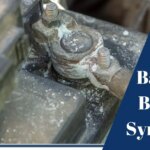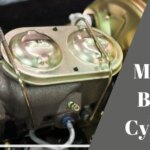
Wondering about oil in intercooler? The intercooler pipe cools the air that circulates inside the pipe to promote combustion. When there is oil in the pipe, the engine will react, and you need to pay attention to possible signs because it has to be fixed.
The reasons, symptoms, and fixes for the issue of oil leaking into the intercooler system will all be examined in this article.
Table of Contents
What Is Intercooler?
A component that cools the airflow entering the engine is the intercooler. It is typically offered in cars with turbochargers or superchargers.
The engine can burn more fuel thanks to the turbocharger’s assistance in compressing air from the outside. The gas stream’s temperature will rise due to the compression.
Because the relationship between the oxygen concentration and air temperature is inverse, there won’t be much oxygen in the gas stream (i.e., the higher the temperature, the lower the oxygen concentration, and vice versa). Since then, the engine’s combustion efficiency has likewise been low.
To cool the air stream after compression, they need an intercooler system.
Oil in Intercooler: Possible Causes
The intercooler does not need any oil in it. Instead, your turbocharger spins up to 280,000 rpm and receives oil lubrication from your engine’s lubrication system.
The seals may start to leak oil over time or, if there is a problem, which causes the compressed air supplied by your turbocharger to build up at the bottom of the intercooler.
Then you can have oil in intercooler symptoms as the oil volume increases, which is undesirable.
The typical sources of oil in the intercooler pipe are highlighted below:
- A clogged filter
- A twisted or blocked oil return pipe
- Turbocharger wrongly fixed
- A faulty turbo
- Too much oil pressure
- Improper gaskets
- Blocked air filter intake
How to Spot Oil in an Intercooler Pipe
A small amount of oil spilling into the intercooler has little impact on the engine. However, the engine would be vulnerable to issues if the oil builds up significantly. As a result, you must quickly learn how to find and rectify oil leaks inside intercooler pipes.
Because the cooling system is buried deep inside the vehicle, you must rely on the vehicle’s indicators to identify issues.
The following signs will let you know whether there is oil in the intercooler pipe or if there is a problem with the intercooler.
# Engine performance is diminished
The engine’s diminished capacity is the first easily observable symptom. Your car accelerates very slowly, and it is challenging to reach the appropriate speed due to insufficient energy from incomplete fuel combustion.
The cause is a lack of oxygen because the intake air stream is not cooled after being compressed by the turbocharger.
The engine is unable to burn fuel effectively as a result. Furthermore, the intercooler pipe’s oil buildup also obstructs the engine’s air intake path. Your engine will suffer as a result over time.
The check engine light will come on if the engine is not functioning properly. It also serves as a warning for you. However, search for further symptoms to verify if the oil in the intercooler pipe is the source of the engine issue?
# Boost fuel usage
Fuel waste is the second outcome of inadequate intake of air cooling. It’s because the cylinders can’t produce enough power and can’t consume all the energy. So in order to reach the target speed, the engine must pump more fuel.
# Unusual exhaust smoke

Oil buildup in the intercooler pipe has the potential to combine with intake air and enter the cylinder.
The oil is burned here, resulting in black smoke. Check the exhaust pipe while the car is running to see if there is oil in the intercooler or not. Your car has an oil and cooling system issue if it emits black smoke.
Solutions to The Problem of Oil in The Intercooler
#1 Installing a stronger bash plate after cleaning and testing
Reputable mechanics should do a pressure test, an interior and external clean, and leak repairs. For better protection and to avoid the issue repeating, some car owners choose a more durable front bumper plate.
#2 Installing a catch can
Installing an oil separator or catch can, a relatively simple process, is one method that can prove to be highly useful. In addition, there are various aftermarket offers and choices.
For instance, one solution to the condensation buildup and oil leaking issue reroutes most of the EcoBoost vacuum lines to the catch.
This technique does have certain disadvantages, though. Installing a catch can mean that you will need to drain it regularly. Recirculating the oil vapor without changing the emissions components should be the goal of a functional catch can.
#3 Engine room ventilation
Today’s new cars are typically turbocharged or supercharged. As a result, issues with oiling and condensation are getting worse.
When there are performance upgrades, the positive crankcase pressure may be more than what the OEM PCV can manage. As a result, the quantity of piston rings blow-by will also rise.
Pulling the inlet hose from the intercooler and noticing greasy sludge oozing out indicates that the PCV is constrained or clogged.
As a blocked PCV system draws oil into the cylinders, carbon stains are left behind, which almost certainly results in a misfire. The PCV system is more than just a check valve in some of the more recent engines. It is more than that, which poses some difficulties.
In more recent vehicles, including those powered by Volkswagen/Audi TFSI engines, a PCV that is integrated into the valve cover and controlled by the ECU is more typical. In turbocharged applications, an oil separator is built into the lid and the PCV system.
In engines like the Audi TFSI, the failure of the diaphragm seal on the oil separator is frequently the cause of misfires. The problem can be resolved by using an aftermarket diaphragm or replacing the entire PCV unit.
The OEM PCV system should typically be able to manage the majority of the crankcase ventilation easily. That is unless you fail to do routine maintenance.
More airflow is needed in enhanced applications over stock to allow crankcase vapors to escape. This problem can be resolved by adding line or decreasing pressure by increasing the hoses’ internal diameter.
How to Clean an Intercooler
The intercooler pipe can be cleaned in two steps: remove it from the car and wash it with detergent.
# Take the intercooler out of the vehicle
This task won’t be too challenging if you know how to remove it. However, to guarantee the security of both persons and cars, we advise you to adhere to the manufacturer’s instructions.
Step 1: Go through the intercooler disassembly instructions.
Manuals and online video tutorials are both options.
Step 2: Take the bumper apart
To secure the bumper to the automobile, tighten the screws using a screwdriver. The entire intercooler and its pipes will now be visible.
Step 3: Take the intercooler apart from the intercooler pipes in step three.
The intercooler will connect a pipe from the turbocharger and a pipe to the engine. The intercooler component can be taken out and separated with a flathead screwdriver. Allow the basin to catch the oil from the pipes while sketching!
# Use detergent to clean the intercooler
All that is left to do is clean the intercooler after it has been taken apart.
- Wear gloves and goggles as a first step.
- Fill the oil tank with the intercooler’s oil.
- The intercooler should be put in a sizable pot or bucket.
- Apply cleaning solution liberally to the intercooler’s surface.
- Use two hoses to spray cleaning solution into the intercooler’s interior through its two attachment holes.
- Hold the intercooler upright and give it 60 seconds to drain any extra oil.
- Soak the intercooler for 15 minutes in kerosene. Soak it in new kerosene for an additional 15 minutes if it is not clean.
- Reinstall the intercooler in the car after letting it naturally dry.
Quick Cleaning Tips for Intercooler Pipes
Cleaning the intercooler is best done in a well-ventilated area. There will be less danger of you breathing in hazardous gases.
- The intercooler parameters for your automobile can be found in the owner’s manual.
- Spray the degreaser liberally to remove all the trash and filth.
- Use a disposable container for the oil and muck you drain from the intercooler.
- To thoroughly clean the intercooler, fill it with kerosene while standing in the soaking bucket.
- Up till the kerosene pouring off the intercooler is clear, keep performing kerosene soaks.
- Check to make sure all the bolts are in their proper places after putting your car back together.
Oil Leak After Changing the Turbocharger
Most of the time, intercooler failure is also a result of turbocharger damage. There are many risks involved with replacing the turbocharger if the installation is not done properly.
The intercooler can become clogged with oil and other debris blown from the turbo, leading to leaks and other issues. Sometimes the new system pressure causes the intercooler to leak, which eventually causes the plastic tank to deform.
If the residue is left in the system after installing the new turbocharger, there is a significant chance of obstruction and increased system pressure. In addition, the intercooler will malfunction since it will have to withstand greater pressure than it was intended to.
The identical issue also surfaces when you manually raise the turbo’s power. The chance of the tank blowing up increases because, in most cases, the intercooler cannot handle the extra pressure caused by this alteration.
In certain circumstances, an untrained technician installs a powerful turbo without first examining the intercooler. The system will then run at excessive pressure, which will cause it to blow oil and other debris that has accumulated in the intercooler into the combustion chamber. If this pressure and the residue that is blown into the combustion chamber are not controlled, there is a higher chance that the engine will sustain damage.
Conclusion
To enable the intercooler to function properly, you need to address the problem of the turbo spilling oil into the intercooler. Otherwise, the engine will get hot, and you won’t be able to get the best performance out of it.
You can call your mechanic to resolve these issues if you don’t know how to fix the turbo leaking.
Hi there! I’m Naomi O’Colman. I’ve got years of experience working at an auto repair shop here in Texas under my belt. On top of that, ever since I was a kid I’ve been passionate about the auto industry. Since I’ve joined the team at automotivegearz.com I’ve been enthusiastically sharing my passion and insights with my readers. I’m dedicated to delivering high quality content and helping you stay up to date with the latest automotive trends and products out there!







